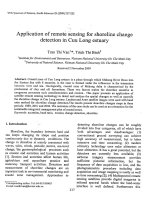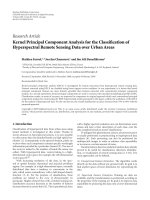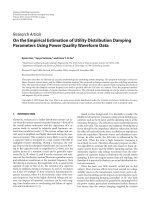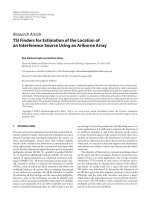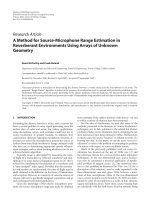estimation of soil moisture using microwave remote sensing data
Bạn đang xem bản rút gọn của tài liệu. Xem và tải ngay bản đầy đủ của tài liệu tại đây (6.68 MB, 181 trang )
ESTIMATION OF SOIL MOISTURE USING MICROWAVE
REMOTE SENSING DATA
by
TARENDRA LAKHANKAR
A dissertation submitted to the Graduate Faculty in Engineering in partial fulfillment of the
requirements for the degree of Doctor of Philosophy, The City University of New York
2006
i
UMI Number: 3231970
3231970
2006
Copyright 2006 by
Lakhankar, Tarendra
UMI Microform
Copyright
All rights reserved. This microform edition is protected against
unauthorized copying under Title 17, United States Code.
ProQuest Information and Learning Company
300 North Zeeb Road
P.O. Box 1346
Ann Arbor, MI 48106-1346
All rights reserved.
by ProQuest Information and Learning Company.
© 2006
TARENDRA LAKHANKAR
All Rights Reserved
ii
This manuscript has been read and accepted for the
Graduate Faculty in Engineering in satisfaction of the
dissertation requirement for the degree of Doctor of Philosophy.
Date Prof. Hosni Ghedira
Professor of Civil Engineering
Chair of Examining Committee
Date Dean Mumtaz K. Kassir
Executive Officer
Supervisory Committee
Prof. Reza Khanbilvardi
Prof. Vasil Diyamandoglu
Prof. Shayesteh Mahani
Prof. Reginald Blake
THE CITY UNIVERSITY OF NEW YORK
iii
Abstract
ESTIMATION OF SOIL MOISTURE USING MICROWAVE
REMOTE SENSING DATA
By
Tarendra Lakhankar
Adviser: Professor Hosni Ghedira
Knowledge of soil moisture helps to derive parameters, such as evaporation,
transpiration, infiltration, runoff and drainage classes, which are very useful in several
agricultural and hydrological applications. Active and passive remote sensing sensors
have shown the capability to estimate soil moisture based on the large contrast between
the dielectric properties of wet and dry soil. However, the retrieval of soil moisture from
microwaves system is mostly influenced by the characteristics of the vegetation cover.
Indeed, having accurate information of the spatial distribution of vegetation (i.e. NDVI
and vegetation optical depth) improves the soil moisture retrieval from microwave data.
The major objective of this research is to develop an algorithm to produce spatial
retrieval of soil moisture using active microwave data. The algorithm will be developed
using a combination of parametric and non-parametric tools such as neural networks,
fuzzy logic, maximum likelihood etc. The study area is located in Oklahoma (97d35'W,
36d15'N). The active microwave data from RADARSAT-1 acquired in SCANSAR mode
were used in combination with the soil moisture data generated from passive
iv
Electronically Scanned Thinned Array Radiometer (ESTAR) during the SGP97 campaign
operated by NASA.
This study will evaluate the contribution of vegetation in minimizing its effect on the
accuracy of soil moisture retrieval. Based on our research, we found that the presence of
higher vegetation cover reduces the accuracy of soil moisture retrieval. The empirical
model to limit the effect of vegetation cover to maximize the accuracy of soil moisture
retrieval has been proposed. The final product of this study, which has been produced, is
a soil moisture map using active microwave data with different level of accuracy. This
research also highlights the impact of spatial heterogeneity in land surface conditions on
soil moisture retrieval from microwave data. Sensitivity of soil moisture retrieval in
spatial heterogeneous area is positively correlated with the type of land-cover.
v
Acknowledgement
First and foremost, I would like to express my deep and sincere gratitude to my
supervisor, Professor Hosni Ghedira, for his support and encouragement throughout my
doctoral study. Prof. Hosni, you are a fantastic mentor, and a nice person. Without you,
this thesis would have been impossible to be complete.
I would also like to thank, Professor Reza Khanbilvardi, for his guidance, encouragement
and financial support over the last three years. It is my privilege to work with Prof. Reza
and NOAA-CREST on such a nice project. I am grateful to Prof. Shayesteh Mahani for
carefully following my work and useful comments and corrections. I also would like to
thank Professor Vasil Diyamandoglu and Reginald Blake for their remarkable advices
and for serving in my PhD committee. Special thanks to Dr. Shakila Merchant for her
cheer and encouragement.
I wish to express my thanks to my colleagues Amir Azar, Juan Arevalo, Cecelia
Hernandez, Heather Glickman, Yajaira Mejia, Bernard Mhando, Kallol Gangul, Rouzbeh
Nazari, Nasim and Nasim at City College of New York for all the discussions,
cooperation and for the wonderful time we have shared during various conference visits.
Heather and Cecelia your last minute help in dissertation correction are very much
appreciated. I also would like to thank Yevgeniy Leykin, Sanchia Peterson, Carla and all
civil engineering staff for their love. My loving thanks are due to Rabi Khan and his
family, for incorporating us in his house and lived like single happy family in New York.
Last but certainly not least, I am short of words, to express my loving gratitude to my
wife, Aparna, for her patience, understanding and support throughout this study, and to
my daughter, Astha, who sacrificed 3 years without her mom and dad, are a never-ending
source of love, pride and inspiration to me. This study would not be possible without
inspiration and loving support of my parents, brothers and in-laws.
vi
Table of Content
ABSTRACT IV
ACKNOWLEDGEMENT VI
TABLE OF CONTENT VII
LIST OF FIGURES XI
LIST OF TABLES XIV
NOMENCLATURE XV
ACRONYMS XVI
1 INTRODUCTION 1
1.1 BACKGROUND 1
1.2 THESIS OBJECTIVES 4
1.3 THESIS HYPOTHESES 5
1.4 THESIS OVERVIEW 6
2 LITERATURE REVIEW 7
2.1 SOIL MOISTURE MEASUREMENT 8
2.2 SOIL MOISTURE SATELLITE MISSIONS 11
2.3 MICROWAVE REMOTE SENSING 13
2.4 MICROWAVE REMOTE SENSING AND SOIL MOISTURE 15
2.5 ACTIVE MICROWAVE MODELS FOR SOIL MOISTURE RETRIEVAL 16
2.5.1 Theoretical Models 17
2.5.2 Empirical Backscattering Models 17
2.5.3 Semi-empirical Backscattering Models 19
2.5.4 Linear Relationship 22
2.5.5 Modified Linear Relationship 23
2.5.6 Michigan Microwave Canopy Scattering (MIMICS) Model 24
2.5.7 An Optical/Microwave Synergistic Model 25
vii
2.6 EFFECT OF VEGETATION ON SOIL MOISTURE ESTIMATION 26
3 MICROWAVE THEORY AND SOIL MOISTURE 29
3.1 INTRODUCTION 29
3.2 PASSIVE MICROWAVE THEORY 30
3.3 ACTIVE MICROWAVE THEORY 31
3.3.1 Frequency and Wavelength 34
3.3.2 Incidence angle 35
3.3.3 Polarization 37
3.4 SOIL SURFACE PARAMETERS 39
3.4.1 Dielectric Constant 39
3.4.2 Surface Roughness 40
3.4.3 Soil Texture 42
3.4.4 Topography 43
3.4.5 Observation depth 45
3.5 VEGETATION PARAMETERS 46
3.5.1 Normalized Difference Vegetation Index (NDVI) 46
3.5.2 Vegetation Optical Depth 48
3.5.3 Leaf Area Index (LAI) 50
4 NON-PARAMETRIC METHODS 52
4.1 NEURAL NETWORK SYSTEM 52
4.2 FUZZY LOGIC METHOD 56
4.3 REMOTE SENSING AND NEURAL NETWORK SYSTEM 60
5 STUDY AREA AND DATA ACQUISITION 64
5.1 SGP’97 EXPERIMENT 64
5.2 SOIL MOISTURE DATA 66
5.2.1 Field Soil moisture data 66
5.2.2 Truth Soil moisture Data 71
viii
5.3 VEGETATION AND ANCILLARY DATA 73
5.3.1 NDVI 73
5.3.2 Vegetation optical depth 73
5.3.3 Soil Texture 74
5.3.4 Land-cover data 75
5.4 ACTIVE MICROWAVE DATA FROM RADARSAT-1 SATELLITE 75
5.4.1 Data Acquisition 77
5.4.2 Data Pre-processing 78
5.4.3 Image Registration 79
5.5 TEXTURAL ANALYSIS SAR DATA 80
6 METHODOLOGY AND ALGORITHM DEVELOPMENT 85
6.1 INTRODUCTION 85
6.2 NEURAL NETWORK ALGORITHM 85
6.2.1 Neural Network Architecture 86
6.2.2 Neural Network Training 91
6.2.3 Effect of Threshold Limit 96
6.2.4 Neural Network output 99
6.3 FUZZY LOGIC ALGORITHM 100
6.4 MULTIPLE REGRESSION ANALYSIS 108
6.5 ASSESSMENT AND VALIDATION 112
6.5.1 Categorical Assessment 112
6.5.2 Quantitative Assessment 117
6.5.3 Model Validation 121
7 EFFECT OF VEGETATION ON SOIL MOISTURE RETRIEVAL 125
7.1 INTRODUCTION 125
7.2 EFFECT OF NORMALIZED DIFFERENCE VEGETATION INDEX (NDVI) 125
7.3 EFFECT OF VEGETATION OPTICAL DEPTH 131
ix
7.4 EFFECT OF SUB-PIXEL VARIABILITY OF LAND COVER 133
7.5 SUB-PIXELS VARIABILITY OF SAR BACKSCATTER AND NDVI 135
8 CONCLUSIONS 138
SUGGESTED FUTURE WORK 143
APPENDICES 145
APPENDIX A: IEM MODEL 145
APPENDIX B: SAMPLING LOCATION AND VEGETATION TYPE AND GROWTH STAGE 146
APPENDIX C: VEGETATION PLANT HEIGHT, WATER CONTENT AND BIOMASS AT SGP SITES 147
APPENDIX D: LEAF AREA INDEX MEASURED AT SGP97 SITES 148
APPENDIX E: OPTIMIZATION OF NN ARCHITECTURE FOR NODES IN SINGLE HIDDEN LAYER 149
CONFERENCE PROCEEDING AND PRESENTATION 151
REFERENCES 153
x
List of Figures
Figure 1: Tensiometer for soil moisture measurement 9
Figure 2: A neutron probe for soil moisture measurements (Courtesy: United Nations website) 10
Figure 3: Time-Domain Reflectory (TDR) Soil Moisture Probe 10
Figure 4: Operating frequency and launching year of satellite missions 13
Figure 5: Backscatter contribution from vegetation cover 20
Figure 6: Details of RADARSAT-1 incidence angle, swath width and beam modes 33
Figure 7: Backscatter from forest area to L, C, and X band wavelength 35
Figure 8: Effect of incidence angle of RADARSAT-1 beam mode S1 and S7 on backscatter 36
Figure 9: Horizontal and vertical polarization 37
Figure 10: Backscatter from relative surface roughness 41
Figure 11: Backscatter response to soil moisture at different soil textures (Ulaby et al. 1981) 43
Figure 12: Effect of topography on radar backscatter 44
Figure 13: Penetration depth as a function of moisture content for loamy soil (Ulaby et al. 1996) 45
Figure 14: Spectral reflectance of green and dry vegetation 47
Figure 15: Typical Neural Network (3 Input layer, 2 Hidden Layer, 3 Output layer) 53
Figure 16: A typical fuzzy logic system (Wang and Jamshidi 2004) 58
Figure 17: SGP’97 study region (Jackson et al. 1999) 65
Figure 18: Test sites in the El Reno (ER) area. Coordinates are UTM. 67
Figure 19: Test sites in the Central Facility (CF) area. Coordinates are UTM 68
Figure 20: Test sites in the Little Washita (LW) area. Coordinates are UTM 68
Figure 21: SAR backscattering and L-Band SM for vegetated and harvested area (July 02 data) 69
Figure 22: SAR backscattering and L-Band SM for vegetated and harvested area (July 12 data) 69
Figure 23: Landsat Thematic Mapper false color composite image of study area (SGP’97 website) 70
Figure 24: Relationship of SAR backscattering values with truth soil moisture data 72
Figure 25: Path of Radarsat-1 satellite (Courtesy: Canadian Space Agency) 77
Figure 26: Details of study area with reference to soil moisture and SAR images 80
xi
Figure 27: Textural images generated from SAR image 84
Figure 28: Effect of number of training pixel on classification accuracy 89
Figure 29: Effect of training pixels on variance of the accuracy for 25 runs of model 89
Figure 30: Accuracy of test data with combination of hidden nodes in two hidden layers 90
Figure 31: Accuracy of data with combination of hidden nodes in single hidden layer 90
Figure 32: Standard deviation of accuracy of test data with variation in nodes in the hidden layer 91
Figure 33: Role of each training data set in the training process (Ghedira and Bernier, 2004) 93
Figure 34: Data selection methodology for model development 95
Figure 35: Methodology applied in soil moisture estimation 96
Figure 36: Effect of threshold limit on soil moisture maps (Area A, July 12 data) 98
Figure 37: Effect of threshold limits on pixel classification 99
Figure 38: Data and clusters in selected two dimensions of the input space (SM and Backscatter) 104
Figure 39: Data and clusters in selected two dimensions of the input space (SM and NDVI) 104
Figure 40: Effect of cluster radii on retrieval accuracy for different datasets 105
Figure 41: Sugeno Rule used for prediction of soil moisture 106
Figure 42: Soil moisture map using fuzzy logic method (July 12, 1997) 107
Figure 43: Soil moisture map using the multiple regression method (July 12, 1997) 111
Figure 44: Comparison between neural network (a) and fuzzy logic (b) output 118
Figure 45: BOX plot shows RMSE for 100 models runs of NN, FL and MR output 120
Figure 46: Comparison of soil moisture retrieval from fuzzy model with truth values (July 02 data) 123
Figure 47 Comparison of soil moisture retrieval from fuzzy model with truth values (July 12 data) 123
Figure 48 Comparison of soil moisture retrieval error and its relationship with NDVI (July 02 data) 124
Figure 49 Comparison of soil moisture retrieval error and its relationship with NDVI (July 12 data) 124
Figure 50: Effect of NDVI classes on SAR backscattering and soil moisture relationship 126
Figure 51: Effect of NDVI class on soil moisture classification accuracy 127
Figure 52: Effect of NDVI and soil texture as an input on accuracy of soil moisture retrieval 128
Figure 53 Correlation between NDVI and soil moisture retrieval error (July 02, 1997 data) 129
Figure 54 Correlation between NDVI and soil moisture retrieval error (July 12, 1997 data) 129
xii
Figure 55: Effect of plant height on absolute error in soil moisture retrieval 130
Figure 56: Relationship between NDVI and vegetation optical depth for the study area 131
Figure 57: Effect of vegetation optical depth class on classification accuracy 132
Figure 58: Example of heterogeneity classes 134
Figure 59: SAR variability as function of NDVI values (Area A on July 2nd 1997) 136
Figure 60: SAR variability as function of NDVI variability (Area A on July 2nd 1997) 137
xiii
List of Tables
Table 1: Details of active microwave sensors 12
Table 2: Wavelengths and frequencies used in microwave remote sensing 14
Table 3: Characteristics of RADARSAT-1 satellite 33
Table 4: Parameter used for ESTAR soil moisture estimation for different land cover categories 74
Table 5: Details of soil texture data used as input parameter 75
Table 6: Characteristics of RADARSAT-1 beam mode (Courtesy: Canadian Space Agency) 76
Table 7: Main characteristics of used RADARSAT-1 scenes 77
Table 8: GLCM based features 83
Table 9: Relationship between SAR Textural images using Correlation Coefficients 83
Table 10: Neural network training parameters 94
Table 11: RMSE and correlation values for input variable used in neural network model 100
Table 12: RMSE and correlation values for input variable used in fuzzy logic model 106
Table 13: RMSE and correlation values for input variable used in regression model 110
Table 14: Confusion matrix using SAR for 200 test pixels 114
Table 15: Confusion matrix using SAR, NDVI and optical depth for 200 test pixels 114
Table 16: Normalized Confusion matrix using SAR for 200 test pixels 115
Table 17: Normalized Confusion matrix using SAR, NDVI and optical depth for 200 test pixels 115
Table 18: Z-test of classification results using a 95% confidence level (Z-Score<1.96) 117
Table 19: ANOVA test for RMSE for 100 models runs of NN and FL output 119
Table 20: Model validation using RMSE and correlation coefficient (in bracket) 122
Table 21: Average values of NDVI for different land cover in study area 135
Table 22: Effect of heterogeneity of pixel on accuracy of classification 135
Table 23: Correlation coefficient for SAR variability and NDVI values 136
Table 24: Correlation coefficient for SAR variability and NDVI variability 137
xiv
Nomenclature
ε Dielectric constant
ε’ Real part of the dielectric constant of a soil-water-air mixture
ε “ Imaginary part of the dielectric constant of a soil-water-air mixture
εa Dielectric constant of air
εi Dielectric constant of ice
εw Dielectric constant of water
θ Incidence angle
λ wavelength
ρ
b
bulk density
σ Backscatter coefficient
τ Vegetation optical depth
e
s
surface emissivity
b vegetation absorption parameter
T
sky
reflected sky brightness
T
soil
thermometric temperature of the soil
T
atm
thermometric temperature of the atmosphere
T
S
soil surface temperature
M
v
Volumetric soil moisture
K
ˆ
Kappa Coefficient
R surface reflectivity
R
t
target range
T
B
brightness temperature
G
r
and G
t
received and transmitted antenna gain
P
r
and P
t
received and transmitted power
xv
Acronyms
ASCAT METOP's Advanced SCATterometer
AVHRR Advanced Very High Resolution Radiometer
CMIS Cross-Track Microwave Imaging Sensor
ENVISAT Environmental Satellite (ESA)
ERS ESA Remote Sensing satellite
ESA European Space Agency
ESTAR Electronically Scanned Thinned Array Radiometer (L band)
FIFE First ISLSCP Field Experiment
GCP Ground Control Point
GIS Geographical Information System
GPS Global Positioning System
HAPEX Hydrologic Atmospheric Pilot Experiment
HH Horizontal like-polarization
HV Horizontal-vertical cross-polarization
VV Vertical like-polarization
HYDROS Hydrosphere State Mission
HAPEX Hydrologic Atmospheric Pilot Experiment
ISLSCP International Satellite Land Surface Climatology Project
LAI Leaf Area Index
MACHYDRO Multi-sensor Aircraft Campaign for Hydrology
METOP Europe’s first operational polar-orbiting weather satellite
NASA National Aeronautics and Space Administration
NDVI Normalized Difference Vegetation Index
NERC Natural Environment Research Council
NPOESS National Polar-orbiting Operational Environmental Satellite System
OXSOME OXford County SOil Moisture Experiment
PBMR Push Broom Microwave Radiometer
RADARSAT Canadian Radar Satellite
xvi
RAR Real aperture radar
RMSE Root mean square error
SAR Synthetic Aperture Radar
SGP Southern Great Plains Mission (NASA)
SIR-C/X-SAR Shuttle Imaging Radar-C and X-Band Synthetic Aperture Radar
SMEX Soil Moisture Experiments
SMOS Soil Moisture and Ocean Salinity mission
SSM/I Special Sensor Microwave/Imager (Radiometer)
TM Thematic Mapper
VIIRS Visible Infrared Imager / Radiometer Suite
xvii
1 Introduction
1.1 Background
In a remote sensing context, soil moisture represents the amount of water in the top layer
of the soil surface; generally the upper 5 to 10 cm below natural ground surface. The
temporal and spatial variations of soil moisture represent two key parameters for various
hydrological modeling processes. With the actual field measurement techniques, it is very
difficult to have a spatial measurement of soil moisture, as it varies spatially and its value
is generally affected by the heterogeneity of soil surface characteristics. The water
content of the upper soil layer, or soil moisture, is being increasingly used as input for
various hydrological modeling processes. Presently, most of the hydrological models
that require soil moisture information use point measurements or spatial distribution of
soil moisture derived from physically-based models.
Spatial distribution of soil moisture is being increasingly used as input to hydrological
models. Having an accurate estimation of soil moisture with acceptable resolution and
revisit times is indispensable for an efficient hydrological modeling and for improved soil
wetness forecasts. Indeed, the of many environmental phenomena such as flooding and
drought extent cannot be captured by ground measurements alone, which explain the
increasing importance of remote sensing in conjunction with ground-based observations
in natural resource management and especially in water resources monitoring and
forecasting. Additionally, improved estimates of spatial and temporal variation of
surface moisture will significantly enhance our ability to more accurately predict the
1
magnitude and the timing of extreme events and natural hazards such as extreme weather,
floods, and droughts.
Active and passive remote sensing systems and especially those operating in the
microwave region of the electromagnetic spectrum have shown the ability to measure the
spatial variation of soil moisture content in the near-surface layer under a variety of
topographic and land cover conditions. Spaceborne active microwave sensors are able to
provide high spatial resolution (up to 10 m), but have low temporal resolution and are
more sensitive to surface characteristics than passive systems. However, passive
microwave sensors provide low spatial resolutions (40 to 50 km) with a higher temporal
resolution (12 to 24 hrs). Most of the applications of active microwave in soil moisture
retrieval are based on the hypothesis that the signal backscattered from the observed
scene is widely dependent of the dielectric contrast that exists between wet and dry soils.
Indeed, under the same land cover condition, the stronger radar backscattering values are
observed for high soil moisture. However, soil moisture estimation based on active
microwave data only may face several challenges since the microwave sensors are
sensitive to other land cover characteristics such as vegetation density, surface roughness,
and soil texture (Engman and Chauhan 1995; Hall et al. 1995; Ulaby et al. 1981; Ulaby et
al. 1986b).
This study is motivated by the recent and intensive research activities currently underway
by the European and US scientific communities to design the two upcoming satellite
missions fully dedicated to soil moisture mapping from space: ESA
1
’s Soil Moisture and
1
European Space Agency
2
Ocean Salinity Mission (SMOS) and NASA’s Hydrosphere Sate Mission (HYDROS)
exclusively dedicated for soil moisture retrieval. SMOS mission is designed to use a L-
band interferometric radiometer to make measurements at a spatial resolution of about 40
km and HYDROS will combine a passive radiometer (40 km) and an active scatterometer
(3 and 10 km). The expected launch dates for these missions are 2007 and 2010,
respectively. These two missions are first-of-a-kind exploratory measurements and aim
to measure soil moisture with an accuracy of 0.04 m
3
m
−3
(4%).
The accuracy of satellite-derived soil moisture is usually affected by the presence of
vegetation which significantly modifies and attenuates the outgoing microwave radiation
of the soil and makes the retrieval of realistic soil moisture from satellite-based sensors
difficult and inaccurate. Soil moisture estimation by active remote sensing involves the
measurement of backscattering which may be affected by both vegetation canopy and soil
moisture. The vegetation canopy may affect the backscattered energy by contributing to
the volume backscatter of the observed scene and by attenuating the soil component of
the total backscatter (Ulaby et al. 1981; Kasischke et al. 2003). The total amount of
attenuation and backscatter depends on several vegetation parameters, such as vegetation
height, leaf area index, and vegetation water content; and on sensor-related characteristics
such as angle of incidence, frequency, and polarization. Indeed, it is expected that the
presence of high and dense vegetation decreases the correlation between the
backscattering and the soil moisture.
An accurate retrieval of soil moisture from microwave sensors under the complex
conditions explained above seems difficult using a simple linear or non-linear algorithm.
However, a combination of parametric and non-parametric tools may serve as a better
3
alternative. Parametric models such as maximum likelihood are based on statistical
assumptions where coefficients of linear and non-linear models are assumed to be a
function of the input variables. On the other hand, non-parametric models, such as
artificial neural network and fuzzy logic do not require a priori assumptions about
statistical behavior of the data or about any specific relationship between variables.
These models use the data itself to extract the relationship between the input and output.
In this study, we focus on the development of a soil moisture retrieval algorithm by using
tools such as neural networks, fuzzy logic and multiple linear regression models to
produce high-accuracy soil moisture maps from active microwave data.
1.2 Thesis Objectives
The primary intent of this study is to produce spatial soil moisture maps from satellite
active microwave data, which will be used as an additional input to the advanced
hydrologic prediction system (AHPS) operated by NOAA National Weather Service.
Adding an accurate estimation of soil moisture distribution to the AHPS will improve its
flood forecasting accuracy and flash flood warning capabilities. AHPS was designed to
provide forecasts of river levels and river flow volumes in time frames ranging from
hourly to seasonally at local and regional scale. The main objectives of this thesis are:
• The first objective of this study was focused on developing an appropriate algorithm
for soil moisture mapping from active microwave data. To produce soil moisture
maps, an algorithm based on Fuzzy Logic and Neural Network will be developed,
optimized and validated. The algorithm uses active microwave data acquired from
RADARSAT-1 satellite operating at 5.3 GHz with 25 m spatial resolution.
4
• The second objective of this study was to assess the effect of vegetation on soil
moisture retrieval. The measured backscatter from microwave sensors is sensitive to
the structure and the density of vegetation. The normalized difference vegetation
index (NDVI) and vegetation optical depth will be used as additional inputs to the
Fuzzy Logic and Neural Network algorithm.
• The third objective of this study is to review the effect of sub-pixels variability of land
cover on soil moisture retrieval. The variability of land cover within small area is
expected to have an effect on soil moisture accuracy.
A multiple linear regression model has been also proposed to retrieve soil moisture from
Radarsat-1 data. The choice of the study areas for this work was driven mainly by the
availability of intensive field data collected by NASA, USDA, NRC and around 25 other
institutions and organizations during Southern Great Plains Mission in 1997.
1.3 Thesis Hypotheses
The research study presented in this thesis is based on the four following hypotheses:
• First, soil moisture can be estimated from active microwave backscattering based on
the large contrast in the dielectric constant between wet and dry soils.
• Second, the relationship between radar backscattering and soil moisture may be
affected significantly by the presence of vegetation and its characteristics: density,
structure, moisture content etc.
• Third, non-statistical models (i.e. neural network and fuzzy logic), are more suitable to
define the relationship between radar backscattering and soil moisture and to
assimilate additional information to the model (i.e. vegetation related information).
5
• Fourth, taking into account the level of land cover heterogeneity during the mapping
Process could improve the soil moisture retrieval in heterogeneous areas.
1.4 Thesis Overview
This dissertation is structured as follows: In Chapter 2 the scientific background of the
application of microwave in soil moisture retrieval is discussed. A review of previous
relevant research and their contributions to the problem of interest are presented in
Chapter 3. In Chapter 4, a detailed description of neural network and fuzzy logic
methods has been given. Chapter 5 describes the study area, the collection and
processing of satellite and field data. The development, calibration, and validation of the
retrieval algorithm are presented in Chapter 6. The findings of this research and results
discussion are presented in chapter 7. Chapter 8 concludes the dissertation.
6
2 Literature Review
Life cannot exist without water. Water covers 71 percent of the earth surface; of that
amount, oceans make up 97.2 percent; polar ice 2.15 percent and groundwater represents
0.63 percent. Soil moisture is the amount of water in the top layer of the earth surface;
that within reach of plant roots constitutes 0.005 percent of global water. Despite its
small amount, soil moisture plays an important role in the interaction mechanisms
between hydrosphere, biosphere and atmosphere as well as disciplines such as
meteorology, hydrology, agriculture and climate change. In the agricultural field, soil
moisture plays a dominant role in determining crop yield potential for irrigation
management. Information on saturated soil conditions, which have reached field
capacity, can serve as early warning tool for possible flooding. Soil moisture content is
important for watershed modeling that ultimately provides information on hydroelectric
and irrigation capacity. In meteorology and climate change, soil moisture directly affects
the partitioning of energy at the surface between latent and sensible heating. Evaporation
will predominate at higher soil moisture, adding to atmospheric moisture content.
The spatial and temporal distribution and quantification of soil moisture over large
regions enhances estimates of evapo-transpiration through the influence on partitioning of
available energy at the ground surface into sensible and latent heat exchange (Entekhabi
et al. 1994). The weather predictions models require extensive information about the
interaction of land surface processes. The partitioning of precipitation between runoff
and infiltration is necessary for flood forecasting. Soil moisture information is important
economically due to water conservation benefits through rational irrigation scheduling,
7




